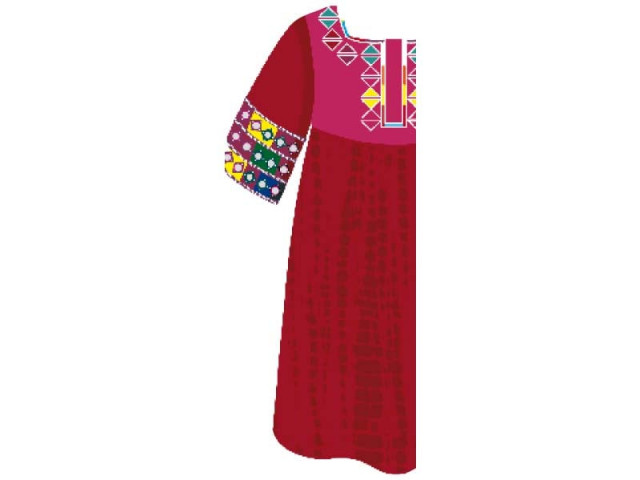
What you wear is mute testimony of who you are and where you come from. The traditional dress worn by the people of Waziristan is no different.
Ganr Khat, a dress designed for women to suit the climatic conditions of the area, depicts the story of a region, a culture and a people.
The term Ganr Khat encompasses the entire attire worn by women. However, it is predominantly used to describe the qameez or shirt worn by brides and married woman. The dress is shaped like a frock and is sewn with around 30 to 35 metres of cloth.
The front of the dress is embroidered with motifs and embellished with ornaments. “Ganr Khat requires a great deal of work,” Namai Bibi, who has made the dress in the past told The Express Tribune. “It is sewn and embellished with care. Women gather at partowgais (a place where women sit to talk) and stitch the dress as they sing [to tappay].”
Since it is made with separate pieces of cloth, each part has its own name and value. Tapper, the pocket of the dress which is stitched on the inside of the dress, can hold many items at once. It is tightened with a rope, which is tied in the dress so that it does come in the way while women work at home or outside.
Although it is stitched at home, the dress can be costly, depending on the type of cloth and embellishments used on it.

The way it was
Ganr Khat bears social significance and remains a dominant feature of Waziristan’s culture. A series of marriage rituals revolved around the traditional dress.
When a marriage is to take place, two Ganr Khat are prepared – one by the family of the bride and the other by the bridegroom’s relatives. Before the wedding takes place, there is an engagement ceremony called Losnewai. The ceremony is held at the bridegroom’s house.
Almost every other girl and woman in Waziristan knows how to embroider the dress. She is supervised by an elderly woman from the family. The dress is stitched with painstaking detail and often takes weeks, even months, to be completed. Once a Ganr Khat is made, it is celebrated on sandarrah. This is usually held on Monday or Thursday when the dress is put on display to be admired by all and sundry.
Men and women participate in Sandarrah and perform the Attan dance. After it is stitched, Ganr Khat is taken to the bride’s house on the wedding day. A man and woman from the bridegroom’s family take the dress to the bride’s house. When they arrive at the bride’s house, the man fires a gunshot into the air to mark their arrival and both men are treated with respect at their house.
The next morning, guests from the bridegroom’s side are served tea and turbans are distributed among the elders. After that, the bride, who is wearing a Ganr Khat, goes to the bridegroom’s house. There is another form of the dress called Kundai Khat that is worn by unmarried girls and women.
Vanishing splendour
The vigour of celebrations has faded over the years. Nowadays, when marriage ceremonies take place, only a limited number of people participate in the festivities. Ganr Khat is no longer worn by married women on a regular basis. It is mostly worn on Eid.
Although the tradition remains alive in some mountainous areas, it has been lost to the growing scourge of militancy. Religious conservatism has compelled women from the region to don burqas and become removed from the fabric of social life.
Sound of music
Recently, a resident of Kari Kot village in Wana, South Waziristan Agency, Umer Shah, has written a song about Kundai Khat. It has been sung by Syed Alam Mehsud and has gained considerable popularity.
While talking to The Express Tribune, Umer Shah said, “This is a song of the [Waziristani] culture and I’m happy that people have appreciated it.” He said he would urge the government to include Pashto in the school curricula so that students of the areas could learn about their culture. “It is our mother tongue and we should not lose it but try to preserve it,” he said.
Published in The Express Tribune, April 3rd, 2016.












COMMENTS
Comments are moderated and generally will be posted if they are on-topic and not abusive.
For more information, please see our Comments FAQ